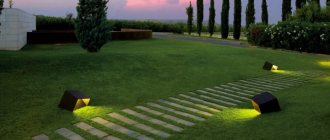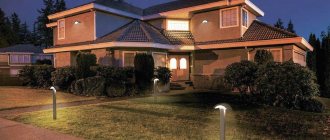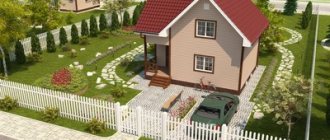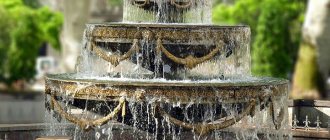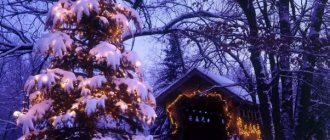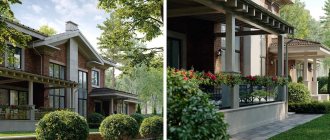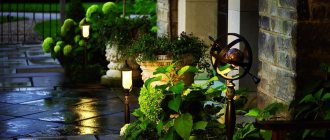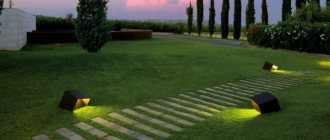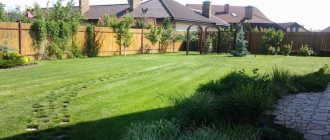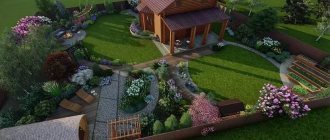To get at least a little escape from the endless bustle of big cities, their inhabitants love to spend weekends at their summer cottage. Alas, ordinary people do not always have time to complete all their business before dawn or spend a pleasant evening on the street because it gets dark. Well-equipped lighting in the country helps solve this issue. And in order for street lighting in a suburban area to be safe and as efficient as possible, it is necessary to comply with the basic requirements for lighting devices.
How does LED lighting work and why is it so popular?
In LED lighting, the light source is an LED, a semiconductor device with an electron-hole junction that produces optical radiation when electric current passes through it in the forward direction. Different types of LEDs differ in brightness, power and other characteristics, but it is believed that using all of them is more profitable than classic Ilyich lamps. Let's compare:
- an incandescent lamp in total can burn no more than 1000 hours;
- LED up to 100,000 hours (11 years).
LED lamps are also valued for their high light output.
- The luminous efficiency of an incandescent lamp is 7-17 lumens per watt;
- LED lamp - 50-100 lumens per watt.
Norms and requirements
When designing and installing street lighting in the yard, it is important to be guided by basic standards, which in the future will ensure not only the ease of use of the local area, but also human safety:
- In accordance with clause 6.3.1 of the PUE for external lighting devices in the yard, you can use lamps of any principle of operation with the exception of security alarm devices, in which the installation of gas-discharge equipment is not allowed
- The installation location of lighting devices can be organized both on free-standing supports and on structural elements of buildings, structures, on the ground, on cables according to clause 6.3.2 of the PUE . But when hanging on a rope in accordance with clause 6.3.4 of the PUE, measures must be taken to prevent them from swinging.
- In relation to the ground, in accordance with clause 6.3.6 of the PUE, you can choose any height, however, when installing yard lighting in the ground, you must provide the installation site with a drainage system.
- If the luminaire is located on any structures below 2.5 m in accordance with clause 6.1.15 of the PUE, their level of protection from dust and moisture must be at least IP54.
- In accordance with clause 6.6.8 of the PUE, the installation of lighting devices must ensure a sufficiently reliable degree of fixation.
- Based on the requirements of clause 6.6.1 of the PUE, the installation location of lighting devices in the yard should be chosen so that there is easy access to it.
- In the regulations of clause 6.6.4 of the PUE , suspended models with a flexible holder are lowered no lower than 1.5 m, otherwise anti-swaying devices are applied to it.
What technical characteristics of LEDs should you pay special attention to when purchasing?
When it comes to diodes, slightly different parameters are important than in traditional types of electric lighting. The most important parameter is luminous flux (lm or lm). It shows how much light energy the lamp gives off. They also use the “luminous efficiency” (lm/W), which indicates how effective the light device is.
Luminous flux is inextricably linked to color temperature , which shows in what shade the lamp glows. Color temperature is measured in Kelvin. Experts recommend warm colors for residential premises, and neutral colors for the office, kitchen and bathrooms. If the lamp uses LEDs with TC≥5300°K, it is not suitable for home lighting.
Another important indicator is power . The power of a LED lamp is calculated using the formula:
Divide the desired wattage of a traditional incandescent lamp by eight.
But manufacturers usually mark the LED lamp with the power values of an incandescent lamp that correspond to it.
When choosing an LED lamp, the dispersion angle - this parameter shows how widely the light flux spreads in space. A lamp for general use must have an angle of at least ≥210°.
Dale85FORUMHOUSE user
And where directional light is needed, a lamp with a dispersion angle of 120 degrees is suitable.
Easy installation
Repair and installation of LED lamps does not require any special knowledge or effort. In addition, if your task is decorative lighting, then LEDs are the most optimal solution. They make it possible to set the backlight to any of the colors of the spectrum and adjust its brightness. Thanks to all of the above features, LED lamps are widely used. They are used for street lighting, building lighting, decorative lighting for furniture and interiors. A high degree of protection from moisture and environmental influences makes it possible to use LED lighting sources for illuminating pools and landscape lighting. Even color and a wide range of colors open up great prospects for designer imagination.
What types of LED lighting can be used in the home?
Three types of lighting fixtures are usually considered
- LED Strip Light
- LED ceiling light (chandelier)
- led panels
Each device solves specific problems.
An LED strip (a flexible board with diodes, each of which is enclosed in a housing and conductive copper tracks) located behind the cornice and directed at the white ceiling turns it into a lighting fixture that floods the room with white light, necessary for work, cleaning, etc. Most often used to illuminate interior items. If you mount the tape around the perimeter of the room, you can visually expand the room.
An LED chandelier gives an even, pleasant light without flickering and always decorates the interior.
Ice panels are installed in large rooms; they are thin, so they are great for low ceilings. They are divided into built-in and suspended.
Automation of turning on and off country lighting
The idea of creating a system that could control lighting in a country house with a given logic has been implemented for quite a long time. Therefore, today you can choose the most suitable option for you and purchase a special device.
The most common devices for automatic lighting are:
- photo relay - the system turns on the light in the dacha when the light level decreases and turns it off after sunrise, when the brightness of the sun's rays affects the photocell;
- motion sensor – allows you to turn on the lights in the dacha if movement is detected in any area;
- time relay - allows you to set the time for turning on and off the dacha lighting at a certain frequency;
- microcontroller (for example, based on Arduino) - a more modern solution for operating light in the countryside, allows you not only to set the frequency, but also to change the brightness, sequence, etc.
Which form of LED lamps is better?
It depends on the purpose of the lighting device. Among the variety of LED models, three are the most popular: Pear. This is the most common type of LED light bulbs; it looks similar to a traditional incandescent lamp with a luminous flux distribution angle of 180 to 360 degrees. Suitable for almost any chandeliers, lamps and other devices. Corn . Reminiscent of a corn cob, with “grains” in the form of ice crystals. It glows brightly, but there is little illumination. Such models are used in spotlights.
Candle . Very compact, with low luminosity (500-600 lm), suitable for night lights, table lamps and other local lighting devices.
Useful tips
If you have taken on the task of making lighting in your dacha with your own hands, it will be useful for you to study the advice of experienced specialists on this issue:
- When installing garden lamps, it is better to choose models with a visor. They are much better protected from external factors and will last longer;
- To reduce energy consumption, install solar-powered lighting devices. They are completely autonomous and are perfect for marking or decorative lighting.
- If you are afraid of the costs of purchasing lighting fixtures, make original devices yourself.
- Using a battery, an inverter and an automatic switching system, you can create autonomous lighting.
- Do not connect wires using twists - this is not only unreliable, but also quite dangerous. Give preference to clamps, sleeves, soldered and bolted connections, and be sure to cover them with insulating material.
- When laying cable lines underground, use a pipe or channels; they will protect the conductor much better and can significantly simplify the process of replacing the cable if it fails.
Is it possible to use LED lighting in a cottage as the main one?
Truly high-quality LED lighting is still very expensive, and if the goal is only savings, then there most likely won’t be much point in it.
Vop495
I have not yet seen lamps with normal color rendition that would pay for themselves in at least two years and cost reasonable money.
But from a design point of view, LEDs can be indispensable for a number of solutions (in profile structures, in eaves lighting). FORUMHOUSE users readily use LEDs in shower cabins, kitchen hoods, and bathrooms.
Tulipa1 Member FORUMHOUSE
I have two 12 W lamps (so-called corn) in the bathroom, a 12 W lamp (warm white) in the toilet, and three 16 W lamps (cool white) in the kitchen - my wife is very happy, there’s just a lot of light.
Implementation Guidelines
- You can determine the optimal illuminated areas using portable lamps or spotlights. If necessary, we recommend contacting landscape design specialists.
- Draw a general plan and indicate on it all the zones and the equipment used there. In the future, this diagram will be needed to calculate the required amount of materials.
- Make power management of different zones independent of each other, and controlled by different electrical devices.
- To protect lines from short circuits, provide for the use of circuit breakers; to protect against leaks and electric shock, use RCDs.
- Lay power cables in pipes in compliance with the necessary requirements. It is recommended to entrust electrical installation work to a specialized installation organization.
- Before final installation of lighting equipment, transformers and other devices, check them and ensure their correct operation.
For questions regarding the use and selection of lighting equipment, calculating the quantity and cost of materials, and all other questions that arise, please contact our specialists via online chat or call.
But I still want LED lighting, what are the rules for different rooms?
According to a user of our portal with the nickname Dale85, who is a professional in lighting, the basic rules for LEDs are the same as for other light sources:
- Avoid directional light in the house, which creates unnecessary shadows;
- In the living room, place the chandelier closer to the seating area and away from the passage;
- The kitchen must have a lamp above the table;
- A common mistake is sconces in the bathroom. There you need a full-fledged light source from the ceiling;
- The hallway and boiler room need a lot of light.
Plant lighting
I would like to say a few words separately about plant lighting. Low plants are usually lit from below, but trees can be lit from above, below or from the side. The choice of lighting depends on the texture of the trunk, the height of the tree, the shape of the branches and crown. So, for example, if a tree has a beautiful trunk, it is better to light it from below, placing the lamp at the roots. For trees with a dense crown, you can use several spotlights located around. When the tree is very tall, it is better to mount the spotlight on the trunk. This technique will highlight interesting fragments of foliage from the inside. Spruces and other conifers are usually illuminated from below, placing spotlights on the ground at a short distance from the lower branches. Silhouette lighting of trees is very fashionable now. In this case, the light source is located behind the tree or bush.
Wind power plants for summer cottages
The topic of wind power plants is very broad and requires special attention. Such power plants are used for dacha lighting less often than solar panels, but this option should not be completely ruled out.
Components
The wind power plant includes:
- Blade rotor. There can be 2, 3 or more blades.
- Gearbox. Changes the rotation speed between the generator and the rotor.
- The “tail” of the windmill directs the structure into the wind.
- Frame. Protects internal elements of equipment from mechanical impacts.
- Battery. Accumulates electricity and releases electricity under adverse weather conditions.
- Inverter. Converts direct current to alternating current.
Classification
Wind turbines are classified according to several criteria that must be taken into account when choosing equipment.
In the direction of rotation of the blades:
- horizontal;
- vertical (more stable).
Number of blades:
- two;
- three;
- multi-lobed.
According to the material:
- hard;
- sailing (more affordable, but less durable).
Control type:
- fixed step;
- changing step.
Operating principle
A wind power plant works on the following principle. The wind rotates the blades fixed on a metal mast. As a result of rotation, the generator rotor begins to work, which produces alternating current.
The latter enters the converter, where the alternating voltage is converted into direct voltage. A wind of 4-5 m/s is sufficient for operation.
According to the operating principle, wind generators can:
- Work in parallel with solar power plants (batteries), gasoline (diesel) generators, backup batteries.
- Autonomous.
Selecting the size and installation location
When choosing dimensions, it is necessary to determine the amount of energy consumed. For the calculation, the formula is used: AEO = 1.64*D*V, where:
- AEO - the amount of electricity consumed per year;
- D—rotor diameter (m);
- V is the average annual wind speed (m/sec).
Taking into account the information received, a decision can be made on the parameters of the wind turbine.
When determining the installation location, consider the following:
- There should be no trees, buildings or other objects nearby that could interfere with the work.
- Installation is carried out on a special structure, which must be several meters higher than the obstacle located at a distance of at least 200 m.
- The distance from the windmill to residential buildings is about 30-40 m to reduce the sound from the rotation of the blades.
Wind power plants have certain advantages. Their effectiveness does not depend on the time of year, and the payback period is 5-7 years. Parts wear out slowly, so the equipment can last more than three decades.
But there are also disadvantages: a high mast, the need for constant maintenance and the risk of equipment damage when weather conditions worsen.
Darkness is a friend of youth, but light is more fun
And this is where we think about lighting. The first thing that comes to mind is to look at a photo of the lighting of the site. And what do we see? A huge number of creative solutions. And this is far from a garden lantern on a table, as was commonly believed.
Incredible beauty opens before our eyes. And you can either do all this yourself, or buy it in a store and install it.
What to consider when choosing garden lamps?
The lamp in the country will be constantly influenced by negative environmental factors: precipitation, sunlight, high and low temperatures. This means that you need to choose only those products that are intended for outdoor use. They must be sealed or semi-sealed. In the latter case, you will need to take care of the presence of canopies from snow and rain.
When purchasing, you should check whether the inside of the lamp mount is painted or not. In the latter case, you should not count on long-term use. Lamps made of stainless steel and aluminum alloys have proven themselves better in use. Do not forget about the warranty period; ask the seller for a safety certificate, which should indicate the degree of protection.
Light tasks
Outdoor lighting serves not only as a decorative element (for illuminating parties), but also performs an aesthetic function.
In addition, the area filled with light repels all kinds of intruders. There are so many lighting options on the site that every homeowner can choose his own.
Where is light needed?
Professionals believe that it is imperative to conduct electricity near the main building, in the local area, in garden alleys, on verandas, near ponds and plants.
Properly executed street lighting in a suburban area will fill the atmosphere in the evening with magic.
